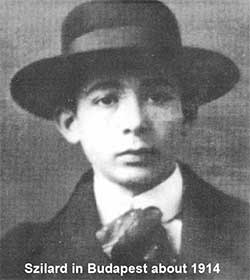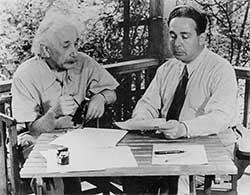The Many Worlds of Leo Szilard: Physicist, Biologist, and Peacemaker
by William Lanouette


Albert Einstein and Szilard recreate drafting the famous 1939 letter
At the April 2014 APS meeting in Savannah, a panel honored two notable anniversaries: the 50th of Leo Szilard’s death, and the 75th of the Einstein/Szilard letter to President Franklin D. Roosevelt that led to America’s development and use of atomic bombs during World War II. “The Many Worlds of Leo Szilard” convened two scientists who knew him with his biographer for talks rich in both professional and personal details.
The session was hosted by MIT physicist Daniel Kleppner, who said Szilard was “one of the most remarkable minds of his generation in the 20th century, and a unique personality in physics. He changed the course of history for the United States and most people do not know very much about him.” The panel would rectify that, he said.
William Lanouette, author of Genius in the Shadows: A Biography of Leo Szilard, the Man Behind the Bomb (Skyhorse Publishing, 2013), said that although best known for being the first to conceive and patent the nuclear chain reaction in the 1930s, Szilard had other amazing insights in physics and biology, and devised inventive ways to control the A-bomb he helped create.
In physics, Szilard applied entropy to data in a seminal 1929 paper that laid the basis for “information theory.” As physicist Richard Garwin noted, “Szilard’s path-breaking but initially little-noticed 1929 paper, “On the Decrease of Entropy in a Thermodynamic System by the Intervention of Intelligent Beings’’ spawned much subsequent research. It connected what we now call a bit of information with a quantity k ln 2 of entropy, and showed that the process of acquiring, exploiting, and resetting this information in a one-molecule engine must dissipate at least kT ln 2 of energy at temperature T. His 1925 paper, “On the Extension of Phenomenological Thermodynamics to Fluctuation Phenomena,’’ [based on his 1922 doctoral thesis] showed that fluctuations were consistent with and predicted from equilibrium thermodynamics and did not depend on atomistic theories. His work on physics and technology, demonstrated an astonishing range of interest, ingenuity, foresight, and practical sense.”
Garwin also praised Szilard’s “several … fundamental contributions to nuclear physics, to the neutron chain reaction and to nuclear reactors, and also to electromagnetic pumping of liquid metals.” Szilard codesigned an electromagnetic refrigerator pump with Einstein in the 1920s. In 1939, he co-designed the first nuclear reactor with Enrico Fermi. And in the early 1940s Szilard thought up and named the nuclear “breeder” reactor – which was cooled using his Einstein/Szilard electromagnetic pump.
“I met Leo Szilard, from 1947 to 1952 at the University of Chicago,” Garwin recalled, “where I saw him in the faculty seminar run by Bill Libby, in his lab with Aaron Novick, eventually at dinners, and later, on occasion, in New York or Geneva. I visited Leo in his laboratory at the Institute for Radiobiology and Biophysics, which occupied a new building where I had my office from 1950. There Leo showed me the ‘chemostat’, an ingenious and powerful tool he had invented and developed with Aaron Novick. I recall Leo’s telling me that they had had concern that polyethylene, insulator of high-performance coaxial cables developed during the war, might live forever, immune to degradation by microbes Apparently, though, they had ‘trained’ microbes to subsist on polyethylene – had directed the evolution of microbes by manipulating their environment in the chemostat.”
Garwin said that “After I had been to Los Alamos as a consultant for the first of many summers in 1950-52, before moving from the Physics Department at the University of Chicago in December 1952 to the new IBM Watson Scientific Laboratory at Columbia University, at a cocktail party at the home of Mildred and ‘Murph’ Goldberger, Edward Teller told me of the high regard in which he held Leo Szilard. He said, ‘You know the way I use Freddie De Hoffman for calculations at Los Alamos, that is how Leo uses me.’ Leo Szilard’s ingenuity and inventiveness outclassed those of Edward Teller.”
In biology, too, Szilard outclassed his colleagues. Biologist Francois Jacob called Szilard an “intellectual bumblebee” for the many novel ideas he shared, including one that earned Jacob and others the Nobel Prize. Harvard Biologist Matthew Meselson recalled how impatient Szilard was to learn biology, and to bypass the cycle of submitting papers for peer review simply convened the authors to brainstorm over dinner. To do this he created a “Midwestern Phage Group with monthly meetings that included Alfred Hershey, Joshua Lederberg, Salvador Luria, James Watson, and others.” (All four were later Nobel laureates.) Meselson pointed out that Szilard’s work with the chemostat has generated more than 500 citations in the Proceedings of the National Academy of Sciences.
Also of note is that in the famous 1959 “PAJAMO” paper on negative gene control – nicknamed for Arthur Pardee, François Jacob, and Jacques Monod – the authors noted, “We are much indebted to Professor Leo Szilard for illuminating discussions during this work.” Jacob, Monod, and André Lwoff won the 1965 Nobel Prize in Medicine for this idea, and when receiving the award in Stockholm Monod said: “This is precisely the thesis that Leo Szilard, while passing through Paris, happened to propose to us during a seminar… I saw that our preliminary observations confirmed Szilard’s penetrating intuition, and when he had finished his presentation, my doubts about negative gene control had been removed.”An intellectual bumblebee indeed!
“Theoretically I am supposed to divide my time between finding what life is and trying to preserve it by saving the world,” Szilard wrote physicist Niels Bohr in 1950. “At present the world seems to be beyond saving, and that leaves me more time free for biology.” In fact, Szilard never abandoned hope for saving the world by controlling the spread of nuclear weapons, and Meselson emphasized that even before the A-bomb was dropped on Hiroshima Szilard had tried to stop it. He rallied scientists to lobby for “civilian control” of atomic energy in 1945, attended the first Pugwash Conference on Science and World Affairs in 1957 and influenced many to follow, gaining Soviet Premier Nikita Khrushchev’s personal assent to a Moscow-Washington “Hot Line” during a private meeting in New York City in 1960. And he founded the first political action committee for arms control in Washington in 1962, The Council for a Livable World, which thrives today.
The articles in this issue represent the views of their authors and are not necessarily those of the Forum or APS.
